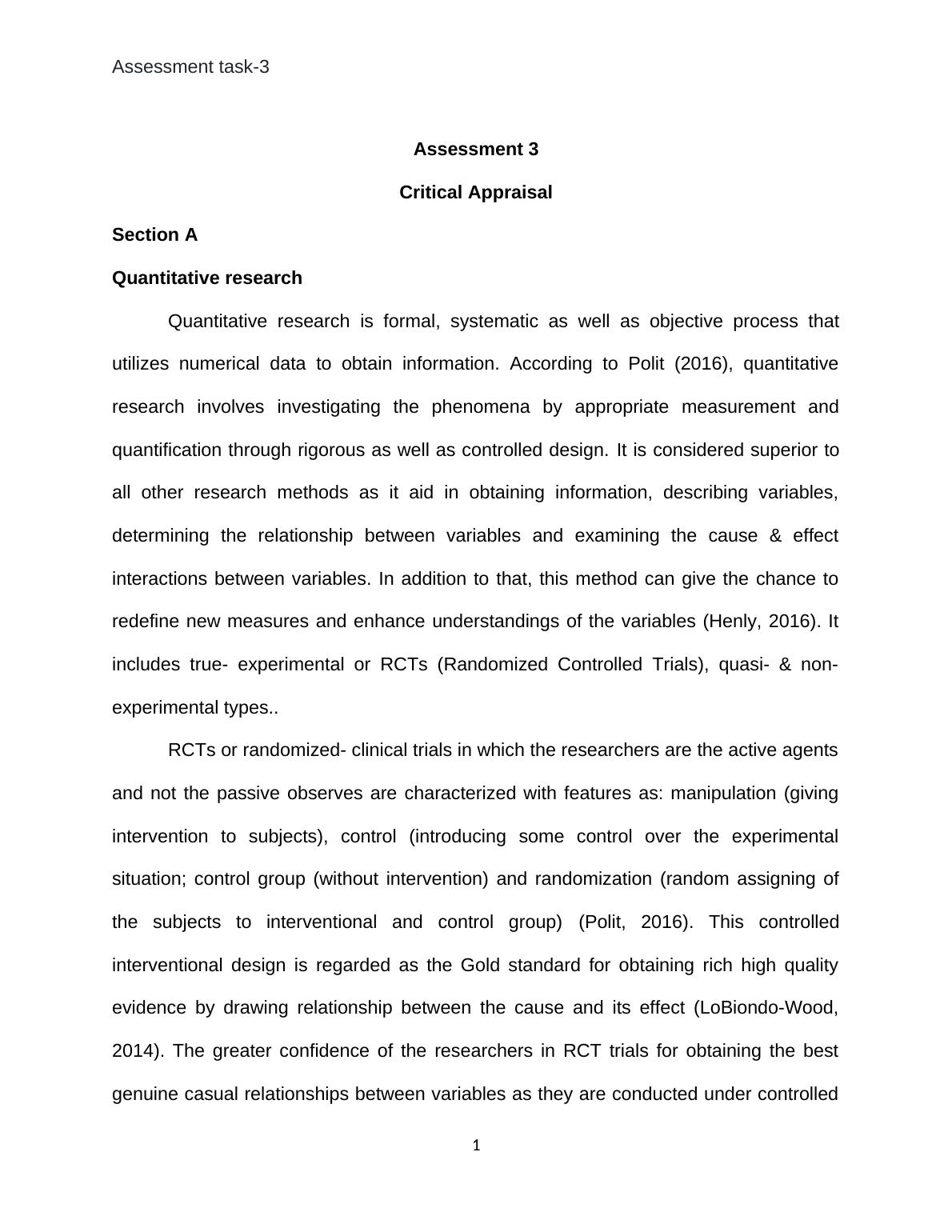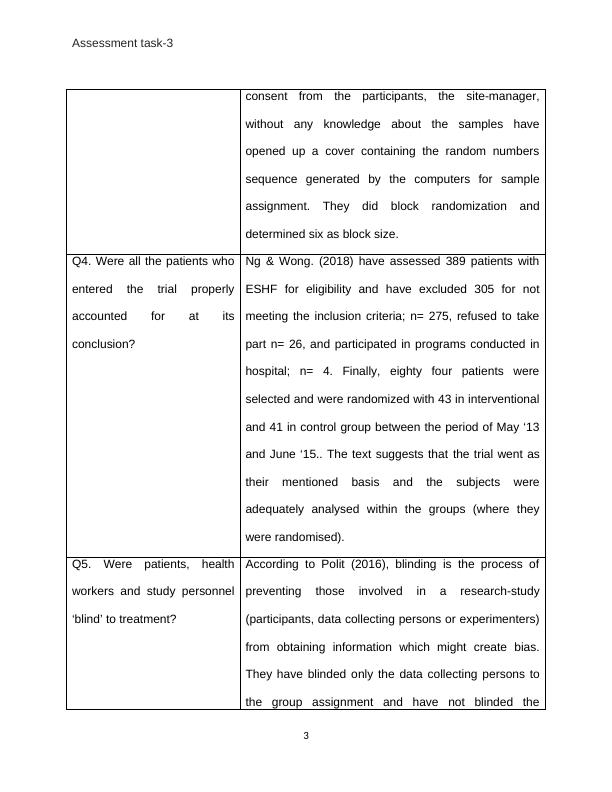Quantitative Research in Critical Appraisal
Added on 2023-03-20
15 Pages3922 Words55 Views
Assessment task-3
Assessment 3
Critical Appraisal
Section A
Quantitative research
Quantitative research is formal, systematic as well as objective process that
utilizes numerical data to obtain information. According to Polit (2016), quantitative
research involves investigating the phenomena by appropriate measurement and
quantification through rigorous as well as controlled design. It is considered superior to
all other research methods as it aid in obtaining information, describing variables,
determining the relationship between variables and examining the cause & effect
interactions between variables. In addition to that, this method can give the chance to
redefine new measures and enhance understandings of the variables (Henly, 2016). It
includes true- experimental or RCTs (Randomized Controlled Trials), quasi- & non-
experimental types..
RCTs or randomized- clinical trials in which the researchers are the active agents
and not the passive observes are characterized with features as: manipulation (giving
intervention to subjects), control (introducing some control over the experimental
situation; control group (without intervention) and randomization (random assigning of
the subjects to interventional and control group) (Polit, 2016). This controlled
interventional design is regarded as the Gold standard for obtaining rich high quality
evidence by drawing relationship between the cause and its effect (LoBiondo-Wood,
2014). The greater confidence of the researchers in RCT trials for obtaining the best
genuine casual relationships between variables as they are conducted under controlled
1
Assessment 3
Critical Appraisal
Section A
Quantitative research
Quantitative research is formal, systematic as well as objective process that
utilizes numerical data to obtain information. According to Polit (2016), quantitative
research involves investigating the phenomena by appropriate measurement and
quantification through rigorous as well as controlled design. It is considered superior to
all other research methods as it aid in obtaining information, describing variables,
determining the relationship between variables and examining the cause & effect
interactions between variables. In addition to that, this method can give the chance to
redefine new measures and enhance understandings of the variables (Henly, 2016). It
includes true- experimental or RCTs (Randomized Controlled Trials), quasi- & non-
experimental types..
RCTs or randomized- clinical trials in which the researchers are the active agents
and not the passive observes are characterized with features as: manipulation (giving
intervention to subjects), control (introducing some control over the experimental
situation; control group (without intervention) and randomization (random assigning of
the subjects to interventional and control group) (Polit, 2016). This controlled
interventional design is regarded as the Gold standard for obtaining rich high quality
evidence by drawing relationship between the cause and its effect (LoBiondo-Wood,
2014). The greater confidence of the researchers in RCT trials for obtaining the best
genuine casual relationships between variables as they are conducted under controlled
1

Assessment task-3
environments is its major strength. They also meet the criteria for establishing causality
which is its added advantage. .
Section-B: Critical Appraisal
Questions Answers
Q1. Did the study ask a
clearly focused question?
The researchers asked a clear as well as focused
study--question with the issue based on the given
treatment (HPHF-program) & the patient-related
outcomes.
Q2. Discuss the
appropriateness of using an
RCT for this study.
This RCT trial seems highly adequate and appropriate
for this study as because the study-researchers have
given home-based palliative HF (HPHF) program as
treatment to the interventional group while kept the
controls without intervention. They have undertaken a
two-group RCT in 3 of the hospitals located in Hong
Kong. They have randomly assigned the eligible
subjects for both experimental as well as control
groups. The experimental group alone were provided
with HPHF program for twelve weeks and were
followed up by home visits and/or by phone calling by
the nursing case managers.
Q3. Discuss how the
assignment of patients to
treatments was randomised
Randomization involves assigning samples to
treatment conditions randomly (Grove, 2015). In this
study, after collecting the baseline data and obtaining
2
environments is its major strength. They also meet the criteria for establishing causality
which is its added advantage. .
Section-B: Critical Appraisal
Questions Answers
Q1. Did the study ask a
clearly focused question?
The researchers asked a clear as well as focused
study--question with the issue based on the given
treatment (HPHF-program) & the patient-related
outcomes.
Q2. Discuss the
appropriateness of using an
RCT for this study.
This RCT trial seems highly adequate and appropriate
for this study as because the study-researchers have
given home-based palliative HF (HPHF) program as
treatment to the interventional group while kept the
controls without intervention. They have undertaken a
two-group RCT in 3 of the hospitals located in Hong
Kong. They have randomly assigned the eligible
subjects for both experimental as well as control
groups. The experimental group alone were provided
with HPHF program for twelve weeks and were
followed up by home visits and/or by phone calling by
the nursing case managers.
Q3. Discuss how the
assignment of patients to
treatments was randomised
Randomization involves assigning samples to
treatment conditions randomly (Grove, 2015). In this
study, after collecting the baseline data and obtaining
2

Assessment task-3
consent from the participants, the site-manager,
without any knowledge about the samples have
opened up a cover containing the random numbers
sequence generated by the computers for sample
assignment. They did block randomization and
determined six as block size.
Q4. Were all the patients who
entered the trial properly
accounted for at its
conclusion?
Ng & Wong. (2018) have assessed 389 patients with
ESHF for eligibility and have excluded 305 for not
meeting the inclusion criteria; n= 275, refused to take
part n= 26, and participated in programs conducted in
hospital; n= 4. Finally, eighty four patients were
selected and were randomized with 43 in interventional
and 41 in control group between the period of May ‘13
and June ‘15.. The text suggests that the trial went as
their mentioned basis and the subjects were
adequately analysed within the groups (where they
were randomised).
Q5. Were patients, health
workers and study personnel
‘blind’ to treatment?
According to Polit (2016), blinding is the process of
preventing those involved in a research-study
(participants, data collecting persons or experimenters)
from obtaining information which might create bias.
They have blinded only the data collecting persons to
the group assignment and have not blinded the
3
consent from the participants, the site-manager,
without any knowledge about the samples have
opened up a cover containing the random numbers
sequence generated by the computers for sample
assignment. They did block randomization and
determined six as block size.
Q4. Were all the patients who
entered the trial properly
accounted for at its
conclusion?
Ng & Wong. (2018) have assessed 389 patients with
ESHF for eligibility and have excluded 305 for not
meeting the inclusion criteria; n= 275, refused to take
part n= 26, and participated in programs conducted in
hospital; n= 4. Finally, eighty four patients were
selected and were randomized with 43 in interventional
and 41 in control group between the period of May ‘13
and June ‘15.. The text suggests that the trial went as
their mentioned basis and the subjects were
adequately analysed within the groups (where they
were randomised).
Q5. Were patients, health
workers and study personnel
‘blind’ to treatment?
According to Polit (2016), blinding is the process of
preventing those involved in a research-study
(participants, data collecting persons or experimenters)
from obtaining information which might create bias.
They have blinded only the data collecting persons to
the group assignment and have not blinded the
3

Assessment task-3
interventionist & the subjects as it was not possible due
to the intervention’s nature..
Q6. Were the groups similar
at the start of the trial?
It is found that the participants in both the groups were
same from the start of this study and other confounding
factors that includes age, gender and societal status
hasn’t affected the study’s outcome,
Q7. Aside from the
experimental intervention,
were the groups treated
equally?
They have followed up the subjects in all the groups &
have collected the data in the similar manner. Thus,
they have treated the groups equally other than the
intervention provided to experiment group.
Q8. How were the data
analysed?
The researchers have utilized PASW software
Statistics-18 for data analyses. They performed
descriptive analyses to draw the frequency and
percentage of the variables and Repeated analysis of
variance to determine the effect of treatment and
control groups on outcome-variables They examined
within-group difference by using Sidak-correction. while
between group comparisons through Friedman &
Mann-Whitney U tests. They performed within-group
analysis by Wilcoxon ranks test while Bonferroni
correction to avoid Type-I error
Q9. How were the results
presented? What are the main
They have well-presented their comparison results in
tabular columns but could have given some pictorial
4
interventionist & the subjects as it was not possible due
to the intervention’s nature..
Q6. Were the groups similar
at the start of the trial?
It is found that the participants in both the groups were
same from the start of this study and other confounding
factors that includes age, gender and societal status
hasn’t affected the study’s outcome,
Q7. Aside from the
experimental intervention,
were the groups treated
equally?
They have followed up the subjects in all the groups &
have collected the data in the similar manner. Thus,
they have treated the groups equally other than the
intervention provided to experiment group.
Q8. How were the data
analysed?
The researchers have utilized PASW software
Statistics-18 for data analyses. They performed
descriptive analyses to draw the frequency and
percentage of the variables and Repeated analysis of
variance to determine the effect of treatment and
control groups on outcome-variables They examined
within-group difference by using Sidak-correction. while
between group comparisons through Friedman &
Mann-Whitney U tests. They performed within-group
analysis by Wilcoxon ranks test while Bonferroni
correction to avoid Type-I error
Q9. How were the results
presented? What are the main
They have well-presented their comparison results in
tabular columns but could have given some pictorial
4

End of preview
Want to access all the pages? Upload your documents or become a member.
Related Documents
Effect of Nurse Empowerment Educational Program on Patient Safety Culture: A Randomized Controlled Triallg...
|9
|2326
|391
Critical Appraisal of Articlelg...
|10
|2111
|232
Module 4 Discussion 13 Randomized Controlled Trial Assignment 2022lg...
|5
|514
|15
Critical Appraisal of Randomised Control Triallg...
|9
|2112
|52
Critical Appraisal of an RCT Research Tool Course 2022lg...
|7
|1664
|14
What is electronic health record (EHR)?lg...
|4
|761
|10
